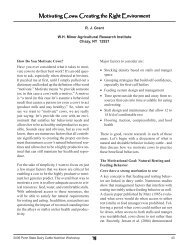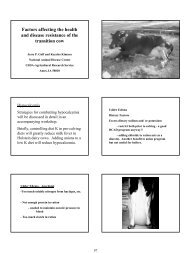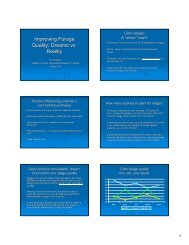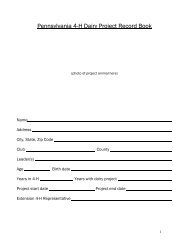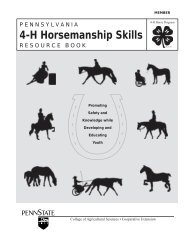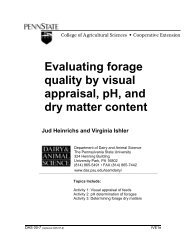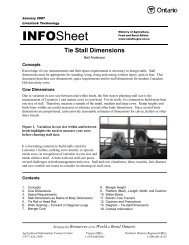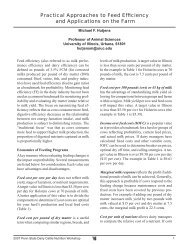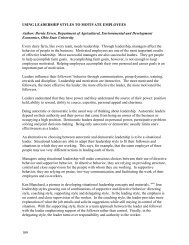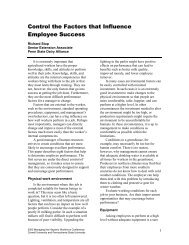DETERMINING THE MINERAL REQUIREMENT OF DAIRY CATTLE
DETERMINING THE MINERAL REQUIREMENT OF DAIRY CATTLE
DETERMINING THE MINERAL REQUIREMENT OF DAIRY CATTLE
You also want an ePaper? Increase the reach of your titles
YUMPU automatically turns print PDFs into web optimized ePapers that Google loves.
these routes can be replaced from dietary Ca, from resorption of Ca stored in bone, or by<br />
resorbing a larger portion of the Ca filtered across the renal glomerulus, i.e. reducing<br />
urinary Ca loss.<br />
Ultimately dietary Ca must enter the extracellular fluids to permit optimal performance<br />
of the animal. Ca absorption can occur by passive transport between epithelial cells<br />
across any portion of the digestive tract whenever ionized Ca in the digestive fluids directly<br />
over the mucosa exceeds 6 mM. These concentrations are commonly reached when<br />
young animals are fed milk. In non-ruminant species, studies suggest that as much as<br />
50% of dietary Ca absorption can be passive. It is unknown how much passive absorption<br />
of Ca occurs from the diets typically fed ruminants but the diluting effect of the rumen<br />
would likely reduce the degree to which passive Ca absorption would occur.<br />
Active transport of Ca is the second route for Ca absorption, and is especially<br />
important when diets are not high in Ca. Active transport of Ca is controlled by 1,25dihydroxyvitamin<br />
D, the hormone derived from vitamin D. Vitamin D, produced within the<br />
skin or provided in the diet, is converted to 25-hydroxyvitamin D in the liver and can be<br />
further metabolized to 1,25-dihydroxyvitamin D in the kidneys. Parathyroid hormone<br />
indirectly stimulates intestinal Ca absorption because it is the primary regulator of renal<br />
production of 1,25-dihydroxyvitamin D<br />
Dietary Ca Requirements<br />
Maintenance<br />
For non-lactating cattle the absorbed Ca required is .0154 g / kg live wt.<br />
For lactating animals the maintenance requirement is increased to .031 g / kg Lwt<br />
-increased dry matter intake increases intestinal Ca secretion during digestion.<br />
Growth - 17 g Ca/ kg live wt gained if live wt is less than 200 kg, 13 g Ca if live wt is<br />
between 200 and 300 kg, 8 g Ca if live wt is between 300 and 450 kg, and 5 g Ca if live<br />
weight is greater than 450 kg.<br />
Pregnancy - Fetal skeletal calcification is especially great in the last weeks before<br />
parturition. The absorbed Ca required to meet the demands of the uterus and conceptus<br />
increases exponentially from 1 g / day at day 190 of gestation to about 10 g Ca/d at<br />
parturition.<br />
Lactation - The absorbed Ca / kg 4% FCM is 1.22 g for Holstein , 1.45 g for Jersey , and<br />
1.37 g for other breeds. Colostrum requires 2.1 g absorbed Ca / kg produced.<br />
Absorption coefficient<br />
To truly determine the availability of Ca from a feedstuff, the animals being tested<br />
should be fed less total dietary Ca than the amount of absorbed Ca required to meet their<br />
needs. This will ensure that intestinal Ca absorption mechanisms are fully activated so that<br />
the animal will absorb all the Ca from the feedstuff that it possibly can. Few studies fulfill<br />
this requirement, thus it is likely that the published studies have underestimated the<br />
availability of Ca in many cases.<br />
Previous NRC publications have determined a single efficiency of absorption of dietary<br />
Ca irregardless of the source of Ca or the physiologic state of the animal. This absorption<br />
coefficient was .38 in the 1989 dairy NRC and .45 in the 1978 NRC based on the average<br />
proportion of Ca absorbed during a variety of trials. The decision to utilize .38 as the Ca<br />
absorption coefficient was based largely on a summary of 11 experiments with lactating<br />
dairy cows in which the average percentage of dietary Ca absorbed was 38. In the<br />
majority of these 11 experiments the cows were fed diets supplying Ca well in excess of<br />
36




